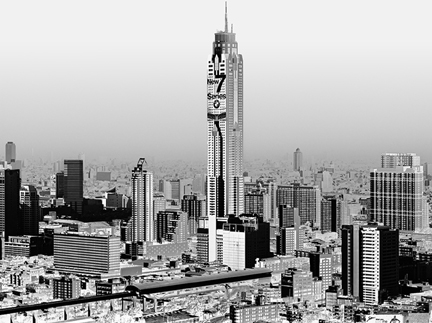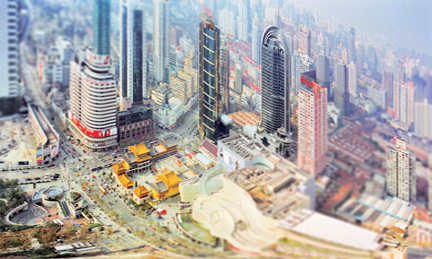About the Photographer
Barbieri, Olivo
Italian, b. 1954
Shooting from a helicopter with a tilt-shift lens, Olivo Barbieri produces selectively focused images that make cityscapes and landscapes look like detailed mini-models. Unlike photographic conventions that play up the magnitude, vigor, and strength of major destinations, Barbieri’s aerial views render such sites inviting and innocent. By blurring imperfections and distorting the scales of his subjects, he re-envisions natural and manmade landmarks as sets akin to toy scenes that we might hold, but knock down by accident. These miniaturized depictions of our environments raise questions about the locations’ malleability and their rapid development in an age of technology and globalization.
Barbieri’s is a meta-practice; his images depict idealistic modes of seeing places as more than the places themselves. During his early career, he experimented with artificial lighting in European and Asian cities while observing their evolution. In 1990s, he began using a large-format camera and tilted lens, which allowed him to accentuate a few details within a vast space and isolate its iconic features. Barbieri’s series, Waterfall Project, references sublime portrayals of the wilderness popularized by art historical figures such as photographer Ansel Adams and Hudson River School painters. Yet, whereas these artists sought the brute realism of natural wonders, Barbieri emphasizes the contrived ways we picture these sites. His image, The Waterfall Project, Niagara Falls, Canada/ US (2007), obscures most of Niagara Falls’ flatter surroundings to zero in on the dramatic meeting place between its explosive water and its skyscrapers. The candy-colored palette and small size of the scene contributes to its staged appearance.
Barbieri further explores visual tropes of the metropolis in his series, Site Specific (2003-2012). This body of work, which originated in Rome, covers multiple cities throughout the world, underscoring and overturning the monumentality of each. For instance, Barbieri ‘s Site Specific: Bangkok (2010) shows a conspicuously stable view of the recently modernized Thai city, by casting it in black-and-white, emphasizing the verticality of its buildings, and omitting any hint of its notoriously bustling and bumpy streets. Barbieri’s over-determined photographs seem to purposefully suppress city-dwellers’ perspectives, suggesting the dehumanizing effects of urban growth. He also grapples with urbanization’s human costs in Site Specific; Shanghai (2004). In this video, subtitled A Silent Story, he provides fairy-tale footage of China’s budding epicenter while inviting audiences to wonder whether such optimistic images of social progress muffle the presence social unrest. Barbieri’s work asks to what extent we are willing and able to perceive our circumstances.
Olivo Barbieri was born in Carpi, Italy in 1954. He attended the Faculty of Pedagogy and then D.A.M.S. Faculty of Arts and Humanities at the University of Bologna. Barbieri has participated in numerous biennales, group exhibitions, and solo exhibitions throughout the world. A sampling of books on his work includes Olivio Barbieri: Dolomites Project (2010) by Olivo Barbieri; Olivo Barbieri: The Waterfall Project by Orazio Barberi (2008); and Olivo Barbieri: Illuminazioni Artificiali by Enrico Ghezzi (1995). He is the recipient of several honors such as the Best Experimental Short award from the Nashville Film Festival (2008); the Overseas Photographer award of the Japanese Higashikawa Prize (1992); and an award from the Graz Media and Architecture Biennale in Austria (2005). His work can be found in the collections of the Gallery of Modern and Contemporary in Torino, Italy; the Museum of Folkwang Essen in Germany; and the San Francisco Museum of Modern Art, among many others.



